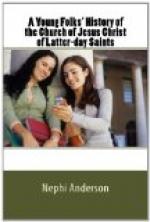He was ordained as one of the Twelve Apostles July 1, 1866.
During the first few years that Wilford Woodruff was president of the Church, the persecution against those who had more than one family continued to rage; yet the enemies of the Saints were not satisfied. Though many of the people had been deprived of the right to vote and hold office, yet there were enough left to outvote the anti-"Mormons,” many of whom were eager to get into some office. These kept urging Congress to pass other laws against the “Mormons,” and at last a number of bills were introduced in Congress for the purpose of disfranchising the “Mormons,” that is, taking away from them the right to vote and to hold public office.
During all this trouble the authorities of the Church were asking the Lord to show them the right thing to do. In answer to these pleadings, the Lord inspired President Woodruff to issue what is called the manifesto. In this document President Woodruff, among other things, said:
“Inasmuch as laws have been enacted by Congress forbidding plural marriages, which laws have been pronounced constitutional by the court of last resort, I hereby declare my intention to submit to those laws, and to use my influence with the members of the Church over which I preside to have them do likewise.
“... And I now publicly declare that my advice to the Latter-day Saints is to refrain from contracting any marriage forbidden by the law of the land.”
At the general conference of the Church held October 6, 1890, President Woodruff’s action was sustained by the vote of the conference.
The enemies of the Church now had no excuse for their persecutions, so, after a time, peace came once more. The two political parties, the “Liberal” and “People’s” which had been for many years fighting each other at the polls, now disbanded, and “Mormons” and non-"Mormons” joined either the Democratic or the Republican party.
In 1893 the great World’s Fair was held in Chicago. In September of that year the Tabernacle choir of Salt Lake City, led by Evan Stephens, went to Chicago, accompanied by the first presidency and others. The choir gave concerts in some of the large cities on the way, and at Chicago carried off the second prize of one thousand dollars for the best singing.
During the World’s Fair there was held what was called a Parliament of Religions. Meetings were convened where people of all religions were invited to speak and tell of their beliefs. Men came from every part of the world. There were Catholics and Protestants; there were followers of Brahma and Buddha from India; there were Greeks and Mohammedans; there were Japanese, Chinese, and negroes—but, among them all there was one religion and one church lacking, and that was the Church of Jesus Christ of Latter-day Saints. It had not been invited, and when Elder B.H. Roberts was sent to Chicago to get a hearing for the Church of Christ, he was treated in an ungentlemanly manner and was not allowed to properly present the claims and doctrines of the Church. The Savior once said: “Blessed are ye, when men shall hate you, and when they shall separate you from their company, and shall reproach you, and cast out your name as evil, for the Son of Man’s sake.” May we not draw a great lesson from all this?




